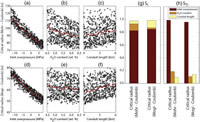Stability of volcanic conduits during explosive eruptions
Aravena A., M. de’ Michieli Vitturi, R. Cioni, A. Neri (2017).
Journal of Volcanology and Geothermal Research, 339, 52-62.
Abstract
Geological evidences of volcanic conduit widening are common in most pyroclastic deposits (e.g. presence of lithic fragments from different depths), suggesting a continuous modification of the conduit geometry during volcanic eruptions. However, the controlling factors of the mechanisms driving conduit enlargement (e.g. erosion, local collapse) are still partially unclear, as well as the influence of conduit geometry on the eruptive dynamics. Although numerical models have been systematically employed to study volcanic conduits, their mechanical stability and the eruptive dynamics related to non-cylindrical conduits have been poorly addressed.
We present here a 1D steady-state model which includes the main processes experimented by ascending magmas (i.e. crystallization, rheological changes, fragmentation, drag forces, outgassing and degassing), and the application of two mechanical stability criteria (Mohr–Coulomb and Mogi–Coulomb), in order to study the collapse conditions of volcanic conduits during a representative explosive rhyolitic eruption. It emerges that mechanical stability of volcanic conduits is mainly controlled by its radial dimension, and a minimum radius for reaching stable conditions can be computed, as a function of water content and inlet overpressure. Additionally, for a set of input parameters thought typical of explosive rhyolitic volcanism, we estimated a minimum magma flux for developing a mechanically stable conduit (~ 7 ∙ 107 − 3 ∙ 108 kg/s). Results are consistent with the unsteady character usually observed in sub-Plinian eruptions, opposite to mainly stationary Plinian eruptions, commonly characterized by higher magma discharge rates. We suggest that cylindrical conduits represent a mechanically stable configuration only for large radii. Because the instability conditions are not uniform along the conduit, the widening processes probably lead to conduit geometries with depth-varying width. Consequently, as our model is able to consider volcanic conduits with depth-dependent radius, two plausible and previously untested geometries have been studied, evidencing major and complex modifications in some eruptive parameters (particularly, exit pressure and mass discharge rate), and suggesting that the geometry acquired by the conduit as it is widened influences the eruptive dynamics.


